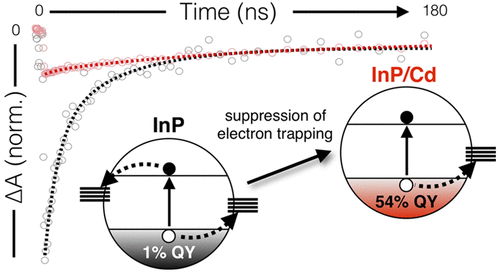Our official English website, www.x-mol.net, welcomes your
feedback! (Note: you will need to create a separate account there.)
Effects of Surface Chemistry on the Photophysics of Colloidal InP Nanocrystals.
ACS Nano ( IF 15.8 ) Pub Date : 2019-11-25 , DOI: 10.1021/acsnano.9b07027 Kira E Hughes 1 , Jennifer L Stein 1 , Max R Friedfeld 1 , Brandi M Cossairt 1 , Daniel R Gamelin 1
ACS Nano ( IF 15.8 ) Pub Date : 2019-11-25 , DOI: 10.1021/acsnano.9b07027 Kira E Hughes 1 , Jennifer L Stein 1 , Max R Friedfeld 1 , Brandi M Cossairt 1 , Daniel R Gamelin 1
Affiliation

|
Indium phosphide (InP) semiconductor nanocrystals (NCs) provide a promising alternative to traditional heavy-metal-based luminescent materials for lighting and display technologies, and implementation of InP NCs in consumer products is rapidly increasing. As-synthesized InP NCs typically have very low photoluminescence quantum yields (PLQY), however. Although empirical methods have led to NCs with near-unity PLQYs, a fundamental understanding of how specific synthetic and post-synthetic protocols can alter the electronic landscape of InP NCs is still lacking. Here, we have studied a series of homologous InP NCs prepared from InP clusters using a combination of room-temperature and low-temperature time-resolved spectroscopies to elucidate how specific charge-carrier trapping processes are affected when various surface modifications are performed. The data allow identification of large PLQY increases that occur specifically through elimination of surface electron traps and provide a rationale for understanding the microscopic origins of this trap suppression in terms of elimination of undercoordinated surface In3+ ions. Despite essentially complete elimination of surface electron trapping when surface In3+ is addressed, hole trapping still exists. This hole trapping is shown to be partially suppressed by even very thin shell growth, attributable to elimination of undercoordinated surface phosphides. We also observe signatures of bright-dark excitonic splitting in InP NCs with only submonolayer surface coverage of select additives (divalent Lewis acids or fluoride anions)-signatures that have only been previously observed in thick-shelled InP NCs. Together, these synthetic and spectroscopic results improve our understanding of relationships between specific InP NC surface chemistries and the resulting NC photophysics.
中文翻译:

表面化学对胶体InP纳米晶体光物理的影响。
磷化铟(InP)半导体纳米晶体(NC)提供了一种有前途的照明和显示技术替代传统的基于重金属的发光材料,并且InP NCs在消费产品中的实施正在迅速增加。但是,合成后的InP NC通常具有非常低的光致发光量子产率(PLQY)。尽管经验方法导致NC具有接近统一的PLQY,但仍缺乏对特定的合成和后合成协议如何改变InP NC的电子格局的基本了解。在这里,我们研究了一系列由InP团簇制备的同源InP NC,它们使用室温和低温时间分辨光谱学相结合来阐明进行各种表面修饰时特定的载流子俘获过程如何受到影响。数据可以识别出大的PLQY升高,这些升高特别是通过消除表面电子陷阱而发生的,并提供了从消除配位不足的表面In3 +离子方面理解这种陷阱抑制作用的微观原因的理论依据。尽管在寻址表面In3 +时基本上完全消除了表面电子的俘获,但仍然存在空穴俘获。由于消除了配位不足的表面磷化物,即使是非常薄的壳生长,也显示出部分抑制了空穴捕获。我们还观察到InP NC中亮暗激子分裂的特征,只有部分添加剂(二价路易斯酸或氟化物阴离子)的亚单层表面覆盖,这种特征以前仅在厚壳InP NC中观察到。一起,
更新日期:2019-11-28
中文翻译:

表面化学对胶体InP纳米晶体光物理的影响。
磷化铟(InP)半导体纳米晶体(NC)提供了一种有前途的照明和显示技术替代传统的基于重金属的发光材料,并且InP NCs在消费产品中的实施正在迅速增加。但是,合成后的InP NC通常具有非常低的光致发光量子产率(PLQY)。尽管经验方法导致NC具有接近统一的PLQY,但仍缺乏对特定的合成和后合成协议如何改变InP NC的电子格局的基本了解。在这里,我们研究了一系列由InP团簇制备的同源InP NC,它们使用室温和低温时间分辨光谱学相结合来阐明进行各种表面修饰时特定的载流子俘获过程如何受到影响。数据可以识别出大的PLQY升高,这些升高特别是通过消除表面电子陷阱而发生的,并提供了从消除配位不足的表面In3 +离子方面理解这种陷阱抑制作用的微观原因的理论依据。尽管在寻址表面In3 +时基本上完全消除了表面电子的俘获,但仍然存在空穴俘获。由于消除了配位不足的表面磷化物,即使是非常薄的壳生长,也显示出部分抑制了空穴捕获。我们还观察到InP NC中亮暗激子分裂的特征,只有部分添加剂(二价路易斯酸或氟化物阴离子)的亚单层表面覆盖,这种特征以前仅在厚壳InP NC中观察到。一起,





















































 京公网安备 11010802027423号
京公网安备 11010802027423号